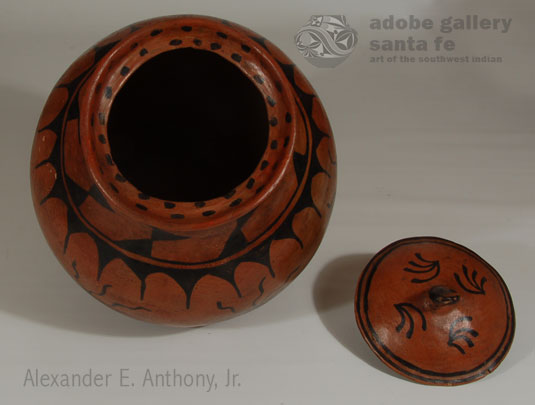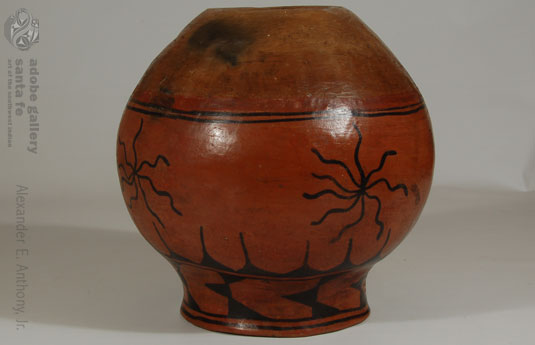Tesuque Pueblo Black on Red Lidded Jar [SOLD]
+ Add to my watchlist Forward to Friend
- Category: Historic
- Origin: Tesuque Pueblo, TET-SUGEH
- Medium: clay, pigment
- Size: 10” height (without lid) x 10” diameter
- Item # C3935 SOLD

Pottery represents the survival of an ancient and primitive craft, going directly back to the days when clay was patted into basketry to make the baskets waterproof. From this primitive beginning, pottery vessels emerged. The pueblo potter then perfected the art until the result was not only a functional item but a beautiful one. One must not overlook the shape of a vessel when concentrating on the design put on it. Often, the shape of the vessel is as pleasing as the design. The two are inseparable.
What pleases us today is what pleased the maker a hundred years ago. Planning what design she was going to place on a vessel was crucial to the outcome. There are hundreds of designs that could be used, but the artist settled in her mind the one she felt would be best. She would use it once, and never again, as the next vessel would receive its own design. Unlike today’s mass-produced items, historic pueblo pottery is unique. There are no two exactly alike.
The typical shape of jars from all the Tewa Pueblos during the period 1760-1880 is globular, approaching spherical. Jars during this period generally had a slight shoulder between the rounded body and the concave neck, as does this one. Harlow 1990
It was not unusual for Tesuque potters to fabricate lids for jars of this type. What is unusual is for the lid to still be intact. So many lids have since disappeared. To support the lid, an extra roll of clay was added at the rim to extend inward about an inch.
The design on the jar is deeply expressive of the artisan. The essence of design is the arrangement and repetition of a few elements. On the neck of the vessel, we see that she chose a single design of black triangles arrange in stacked position. This design is enclosed by dual black framing lines above and below. The lower framing line morphs into rain clouds.
It is on the body of the vessel that she chose to create a design that she repeated five times. It could be described as a celestial element but only the potter could say for sure. Double framing lines enclose the main body decoration. Below the lower pair of framing lines is the un-slipped natural tan clay body that has been polished, over which is placed a red band, typical of the period. The jar dates to the late 1800s.
The lid features a different style of decoration consisting of black lines fanned out like leaves. The handle is a flat clay one tilted slightly. The lip on which the lid rests is decorated with a double row of black dots. Remarkably the lid is in excellent condition and does appear to be original to the jar.
Condition: the jar and lid were examined with UV light and a single vertical slip crack was evidenced, however it appears to have been minor. There are one or two spots where some slip has chipped off, but they are extremely minor.
Provenance: from a gentleman from Santa Fe
Reference and Recommended Reading: Two Hundred Years of Historic Pueblo Pottery: The Gallegos Collection by Francis H. Harlow

- Category: Historic
- Origin: Tesuque Pueblo, TET-SUGEH
- Medium: clay, pigment
- Size: 10” height (without lid) x 10” diameter
- Item # C3935 SOLD
Adobe Gallery Recommended Items
If you are interested in this item, we would also like to recommend these other related items:



